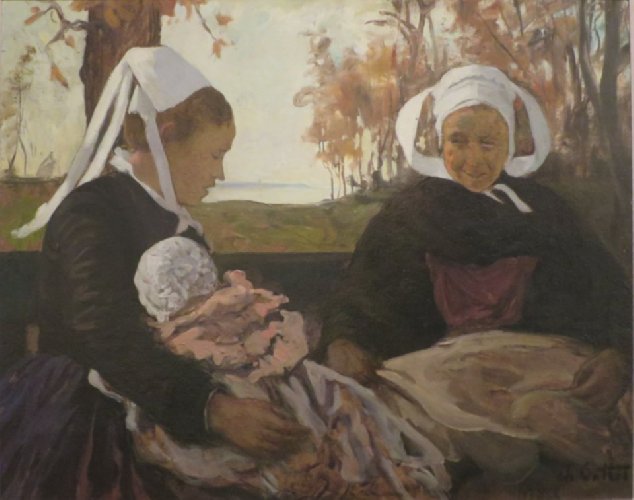Description:
Charles Cottet (1863-1924) studied at the Académie Julian. He regularly visited Brittany, and used motifs from the life of this region in his art, which earned him particular recognition at the Paris Salon in 1893. His paintings showed harsh, majestic landscapes, but also the everyday life of the native Bretons. His painting from Impressionism evolved into darker tones, corresponding to the name of the informal painting group “Black Band” (“La Bande Noir”), of which he was the leader.
Description of the painting:
Charles Cottet was the leader of an informal group of painters known as the “Black Band” (La Bande noir). The name was associated with the color scheme used in the paintings, but also with the traditional black clothing of women in Brittany, because it was there that the artists of this circle created. Such costumes are also worn by the heroines of today’s picture, women of different ages, at three different stages of life. The “Black Band” showed things, ideas, characters, views that they considered valuable and which were lacking in other parts of France. Intergenerational homes, common domestic rituals, family ties, valuing the experience of the elderly – this was an ancient social order that was beginning to disintegrate in the cities. You can also add local patriotism, attachment to Catholicism, or a strong tradition, manifested for example in the clothing worn. Something that was already lacking in multicultural cities. The white caps were especially important for the inhabitants of Brittany, associated with their region. They are still worn by folk groups today.
The women in the painting represent all that the artists were looking for, and in particular their leader, Charles Cottet, author of “A Pleasant Evening in Brittany”.
This longing for constancy, tradition, the old social order, for peace, pure nature was shared by many painters or writers of this time. In the 19th century cities were rapidly developing, factories were being built, railway networks were established. Cities offered more and more comfort, more secure earnings, but also greater haste, anonymity and hard, long hours of work. In addition, the turn of the century was associated with a mysterious fear of the date change, which we even experienced, passing from the 20th to the 21st century. The “Black Band”, despite its name, invites us to a world of order, peace and beauty of nature not destroyed by man.


